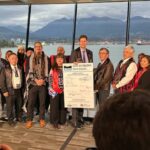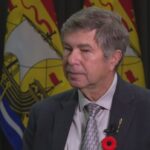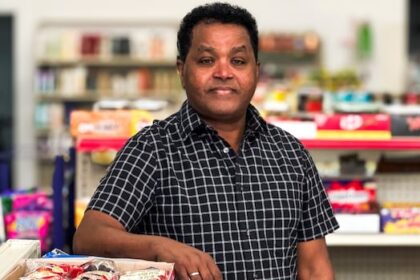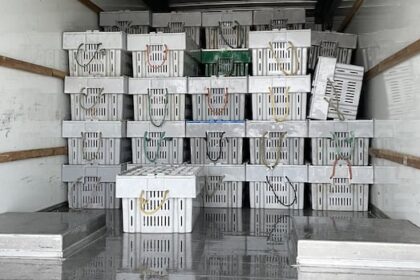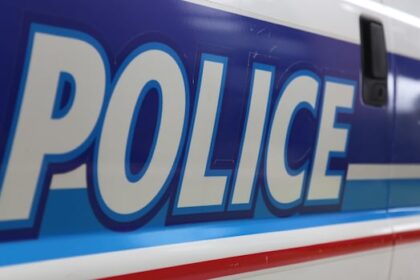The art of Tania Willard is indebted to the land she comes from. “Not only as a place,” says the Secwépemc artist, “but as a collaborator, and as a strategy for resistance.”The multi-disciplinary artist, University of British Columbia professor and Bush Gallery co-founder is known for her exploration of land-based practices, incorporating techniques like birch bark basketry and natural dye making in her art. “The work often starts with a process of being here, where I live on my home territories — on Secwépemc territories — and thinking through ways of increasing connections and knowledge with the land and with community,” she says.“My goal is really to use art and culture in a way that is reparative.”The artist, who lives on the Neskonlith reserve in the B.C. Interior, will represent the Pacific region as one of six finalists vying for the 2025 Sobey Art Award. The honour comes with a $100,000 purse for the grand prize winner, the largest in Canadian art. To get to know this year’s Sobey finalists, CBC Arts sent a questionnaire to each of the contenders. Read on to learn why an artist residency in Rankin Inlet, Nunavut, impacted Willard deeply; how “cute animals” turned her onto artmaking; and why we should make more space for art. The winner of the 2025 Sobey Art Award will be announced on Nov. 8. You can follow all of our Sobey Art Award coverage here.This interview has been edited for length and clarity.WATCH | 2025 Sobey Art Award — Tania Willard:CBC Arts: When did you first know that you wanted to be an artist?Tania Willard: I was sitting at the kitchen table at about 12 years old and I realized I could draw things — mostly cute animal cards I liked to look at. That is when I decided to be an artist. I didn’t have a lot of role models and I lived in a small town with a working-class family and with my dad on the Indian reserve. I am not sure when I even went to my first art gallery, but it was much later in life than maybe someone who grew up in the city. After cute animal cards and art classes at school, I started to be aware of the divide between my school and family in town and my dad on reserve, including the Indigenous art I was seeing from the coast, which was not part of what I was learning in school. I became very invested in learning about art from my Secwépemc side of the family, especially as I learned more about the history of colonization and how it continues to impact my family. Then, art was, for me, a place to call for justice as part of feeling and heart work, and this just became my path because I felt it and I wanted to see change and art is a medium of transformation.What does art give you the opportunity to do? Spend time with the land and family and community. It allows me to feel connected across time and place to creative expression and the critical role that plays. I think we don’t give enough space to art. There are so many more offices and arenas and parks as infrastructure in our cities than there are galleries (though I also challenge the role of the gallery to be more than a white-walled space). But the gallery is a portal that connects over time and place to challenge the normative patterns we have made. It is so important to disrupt those patterns, to reevaluate and transform and invent. That is important way beyond art, but art is where we do that work well. Is there a question, inquiry or investigation central to your art practice? What is it?I question the colonial condition we are in, and it is important to me to find ways to transform, tear down and interrogate that condition. I think, again, the space of artistic practice allows for this critique and envisions new potentials. I am deeply invested in the land, indigenous land rights, the way all people need to connect to land and what our responsibilities are to it as part of our relational ties to each other and the world. Still from Tania Willard Sobey Art Award video, National Gallery of Canada, Ottawa, 2025. (National Gallery of Canada) Why do you practice the disciplines you do? Why do you use the materials you do? What is their significance? I think I start with ideas that come from wanting to learn, and then the medium follows that inquiry. I have worked in so many different mediums, but what is coherent is my commitment to the influence of culture, community and place on us as humans. I am responsive in my practice, and the medium is a part of that response. It might not make sense to make oil paintings in the bush. It might be more important to compose a song or carve antler or dance with others. Or I might be wanting to make a political poster, so I use my printmaking skills. Marshall McLuhan’s “the medium is the message” wasn’t about art practice, but I approach it that way. What do you hope viewers experience through your art?I want everyone to question their assumptions about all kinds of things. I want people to feel, to listen to heart — we all need to listen to heart more — to reflect, to respond and to respect each other, the land and our connections.To work best, what do you absolutely need? Love, connection, hope and curiosity.What was the most impactful work of art — in any medium — you experienced this past year? I was in an artist residency in Rankin Inlet, Nunavut, with Dechinta Centre for Research and Learning and Bush Gallery, and I brought my boys, 14 and 17, with me. We worked with community and amazing artists, and the experience was deeply affirming of the power of art that is experienced in community and collectively through the land. Artist and scholar Krista Zawadski opened her home and family, and the experience was not a white-walled gallery, but a white-covered land, which is deeply cared for, respected and activated by Inuit people always. This experience is what I am dedicated to in my work; it includes family and land, and seeks to transform colonial traumas into possible futures grounded in Indigenous knowledges of land. So it wasn’t about seeing one work, it was about being with artists in community with family and experiencing the land together that was impactful.If you weren’t an artist, what would you like to do for work?I think I would be into ethnobotany or linguistics or biology. That is why I am an artist; I can find pathways through many different disciplines and connect them. I think interdisciplinary practices are so important and we should have artists in residence in so many areas. Believe me — it will make life so much more interesting!Tania Willard, installation view at the Sobey Art Award exhibition, National Gallery of Canada, Ottawa, Oct. 3, 2025 – Feb. 8, 2026. (National Gallery of Canada)Can you tell us about the artwork you’re showing at the National Gallery of Canada for the Sobey Art Award exhibition?I am showing a selection of work that comes from a passion for family, land and community and learning alongside others. From porcelain spray paint cans to birchbark takeout containers, musical scores based on my woodpile and wordless poems made with pigment from berries, my works are materially and conceptually inspired by my land — not only as a place, but as a collaborator and as a strategy for resistance to colonialism. My work is land love and land struggle and land as a lens to understand ourselves and transform. How does this artwork exemplify your practice?I think one work in particular, Surrounded/Surrounding [a wood-burning fire ring], is a good analogue for my work. It was gifted after it was first shown at the Agnes Etherington Art Centre to the Four Directions Indigenous Student Centre (thank you again for letting me borrow it back for the show, 4D!) and has been used by students for years. It is not a pristine art object; it gets used and will be used again. I use it to mark space — what it feels like in the gallery and what it feels like when we bring it outside and light a fire in it and sit together. It asks what we are missing and how we can find it. When I move it back into the gallery, I leave the ashes, so people can see the work has life. This work is accompanied by The Woodpile Score. It is a score based off of my woodpile at home and the ways my dad and his knowledge of the land contribute to our warmth. It also reflects the ways he enacts an everyday sovereignty as a Secwépemc person taught by the grandparents who raised him. At the National Gallery, the work is accompanied by a rendition of the score by Métis soprano Melody Courage, who interprets the score so powerfully. This work really shows the threads of my practice with land, community and family, and the power produced when we come together with respect for Indigenous territories and people. The winner of the 2025 Sobey Art Award will be announced on Nov. 8 in Ottawa. The Sobey Art Award exhibition continues at the National Gallery of Canada through Feb. 8, 2026.
Monday, 22 Dec 2025
Canada – The Illusion
Search
Have an existing account?
Sign In
© 2022 Foxiz News Network. Ruby Design Company. All Rights Reserved.
You May also Like
- More News:
- history
- Standing Bear Network
- John Gonzalez
- ᐊᔭᐦᑊ ayahp — It happened
- Creation
- Beneath the Water
- Olympic gold medal
- Jim Thorpe
- type O blood
- the bringer of life
- Raven
- Wás’agi
- NoiseCat
- 'Sugarcane'
- The rivers still sing
- ᑲᓂᐸᐏᐟ ᒪᐢᑿ
- ᐅᑳᐤ okâw — We remember
- ᐊᓂᓈᐯᐃᐧᐣ aninâpêwin — Truth
- This is what it means to be human.
- Nokoma



